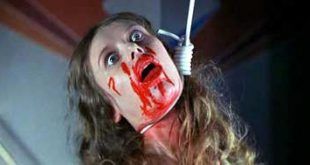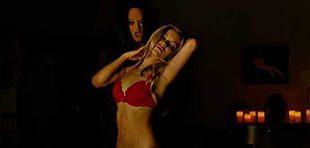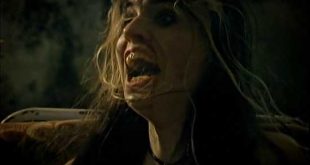Not since the late 1970s and early 1980s when woman revenge films like I Spit on Your Grave and social critiques like Cannibal Holocaust were released has the horror industry produced a burst of socially provocative films like the current wave of violently graphic horror flicks conversing with the existence of torture in Western society. Recent productions over the past decade such as the Saw franchise created by Asian-Australian filmmaker James Wan, the psychological thrillers of Rob Zombie, and socio-politically aware works by Japanese filmmaker Takashi Miike have earned the censorship by various media outlets, the disgust of Christian conservatives, and even the outrage of liberal scholars and critics.
Most poignant are the instances of Showtime refusing to air Miike’s domestic violence and abortion-centered Imprint for fear of being sued by and losing the financial support of Pro-Lifers, Spain’s banning of Saw VI to play only in theatres that show p*rnographic films, the Christian right’s claim that these films are “disturbing and vile” examples of how “we (as a culture) have forsaken God,” and finally, New York magazine’s David Edelstein condescendingly labeling these works as “torture p*rn.”
For better or for worse, the torture p*rn moniker has stuck and critics have tossed it around carelessly like a child with a new toy on Christmas morning. To these critics, horror fans want to see torture and blood and guts and screaming because these fans are depraved and morbid. To them, horror fans are the weird kid living at the end of the block who plays with dead squirrels with a stick and then grows up to decapitate strangers and then collect those heads in a fridge in their basement.
(If this is true, someone needs to inform the Chiller network, because they’ve been playing that abused animal commercial featuring Sarah McLachlan’s song “Angel” every fifteen minutes, tugging at my heart strings so strongly that my wife and I finally caved and bought a new dog.) Critic Christopher Sharrett recently came out in an issue of the Cineaste magazine – a magazine devoted to film and politics – stating that torture p*rn disregards “the psychological content and social criticism of the horror film at its height.” He specifically hammered away at Eli Roth by saying that the director’s DVD commentaries “reveal a mind both confused and uncommitted.” But of course, the proverbial nail in Roth’s coffin as delivered by Sharrett is when he quotes Roth verbatim: “[Horror fans] want to see people getting f*cked up – bad!”
Case closed, right?
Not so fast. Unfortunately, Sharrett paints a picture using broad strokes with only a minimum amount of colors. The aforementioned quote is, in fact, the only quote that Sharrett uses to back up his claim about Roth’s work. What Sharrett – and others – miss out on is the philosophical and political depth behind these recent films. A depth that Sharrett wants to describe as shallow, bankrupt, and falling short of the politically driven work of previous horror filmmakers such as George A. Romero.
In actuality, the depth of Roth’s Hostel is one that harkens back to a concept that philosopher Frederic Nietzsche grabbed hold of in his discussion of the history of tragedy in The Birth of Tragedy. For Nietzsche, tragedy lost its vibrancy as it became increasingly formulaic and ordered. The more predictable the work, the less effective it would be in attacking its audience’s senses. Perhaps one might draw an analogy to the 80s films I grew up on that were often more humorous than necessarily frightening. This isn’t to say that Freddie, Jason, and Michael Myers weren’t at all scary. In fact, the mere concept of these characters could make a five year old wet his or her bed for a good week. However, watch eight or nine of these films and you’ll have the formula figured out in no time – a formula well-documented by critic Carol Clover in her discussion of “the final girl theory” in her book Men, Women, and Chain Saws. (Most of you know it well…if you’re too young, rent Halloween, Friday the 13th, Nightmare on Elm Street, and Sorority House Massacre II and figure out what they have in common…hint: think “final girl”)
What films by Roth and Wan have done is genuinely f*ck up not just their characters, but also their audience. As Nietzsche desired tragedies to truly grab hold off and rattle its audience in order to be successful, these films rattle the cages of even the most depraved individuals. As Eli Roth so eloquently described in his director’s commentary track to Hostel, he normally has “the biggest boner” during a blood and gore scene, but even he had a difficult time keeping his eyes on the monitor while filming the torture scenes. In fact, actors working on his film – and on other torture p*rn films – have come away psychologically shaken (and sometimes physically scarred) by their experiences on these sets.
They’ve put their humanity on the line for the audience and, in turn, the audience has had their humanity ransacked. As for the charge that these films lack the same political force as their predecessors, an even deeper analysis can make one wonder what in the hell movie these critics have been watching. The most socio-politically charged of these films are arguably Eli Roth’s Hostel and Hostel: Part II; and despite frequent admissions by scholars that horror films have long established their reputation as “the most contentious and subversive genre,” Roth’s films have offended critics for their graphic use of torture and superficial political attacks. However, these observations are not only ill-conceived, they often employ an ill-suited feminist or wholly Marxist theoretical lens for understanding the complexity of the work. A complexity that can begun to be unlocked by looking at some of the concepts used by Nietzsche in connection to these films.
In Nietzsche’s second essay of Geneaology of Morals, he offers up a concept known as bad conscience – a quick and dirty explanation of the term is that bad conscience is the idea that humankind is forced to repress natural instincts in order to conform to social structures. So if you’ve got the sexual appetite of a Tiger, but don’t have the means by which to live a sexual life like a Tiger, you repress these sexual appetites and redirect them via another manner or outlet – i.e. masturbating like a drunken monkey or doing yardwork until your arms fall off or reorganizing the living room furniture.
Despite claims that Eli Roth is just being heavy handed in his critique of torture in Western society, Roth’s various depictions of the moderately successful modern day businessman in both films not only converse with Nietzsche’s concept of bad conscience, but also utilizes it to successfully critique the social structure of a Western capitalist system as being both oppressive and a catalyst of sexual perversion thus hammering home a political message Romero can not only be proud of, but also envious of. (See Takashi Miike’s compliment in an interview on the Hostel DVD that Roth has made the last great horror film).
Moreover, both of Roth’s films use of graphic violence in torture and revenge sequences force audiences to truly be horrified and sickened by a horror film – a phenomenon that had long been lost since the popularity of caricatured monsters like Krueger, Myers, and Voorhees dominated cinema screens thereby watering-down the grisliness and socio-political force of a horror film into a palatable digestion of pun-plagued punchlines and exaggerated, cartoonish depictions of blood drenched scenes.
Both Hostel and Hostel: Part II follow a similar plot. In the first film, three males – two college age Americans, Josh and Paxton, and their Icelandic friend, Oli – are backpacking Europe with the goal of getting stoned, drunk, and having sex as much as possible. While in Amsterdam, they are told of a hostel located in Slovakia where beautiful women go crazy for American men due to the exoticness of Americans in that area. When the three guys arrive they are seduced by three Slovakian women. Despite the ominous warning of an Asian girl, Kana, who begs for Josh and Paxton’s help in locating her missing sister as well as the mysterious disappearance of Oli, the boys decide to stay so they can sleep with the girls “just one more time” before heading to Spain.
Unfortunately for Josh and Paxton, they are both drugged by their new Slovkian friends and handed over to an underground Russian organization that sells the young men on the black market for potential buyers who wish secretly and illegally fulfill their wildest fantasies of torture and murder within the confines of the Russian outfit’s remote location. Similarly, the second film centers around three American females – Beth, Whitney, and Lorna – who while studying abroad are convinced by a model from their art class to check out a brothel in Slovakia where they can relax. Once their arrival is secured, the three are listed on a black market Ebay-esque website for a bidding war. One by one, the girls are sold, then subsequently kidnapped for the gruesome, sadistic pleasure of others.
![hostel[1]](https://horrornews.net/wp-content/uploads/2011/08/hostel1.jpg) Perhaps what his most intriguing about these films are not the supposed protagonists of college-age American backpackers, but the motives behind the torture inflicted upon them by their antagonists.
Perhaps what his most intriguing about these films are not the supposed protagonists of college-age American backpackers, but the motives behind the torture inflicted upon them by their antagonists.
(It’s worth noting here that while critic Christopher Sharrett finds the “Eastern European murderers” from Roth’s first film “wholly sinister and merciless, and in several instances repulsive,” the three murderers in Hostel are actually a Dutch businessman, a German Businessman, and an American businessman. In fact, the only Eastern European aspect of the hostel scheme is that it is located in Slovakia and that the local law enforcement is being paid off by the Russian mob that runs it. Instead, these businessmen deftly reflect the danger of bad conscience within various capitalist societies within Western society.)
Regardless of location and ethnicity, the actions and rationale of each businessman is equally grotesque and speaks to the concept of bad conscience in that each individual expresses a suppressed desire for which is their rationale for participating in acts of torture. For example, long before the Dutch businessman, played by Jan Vlasak, drills his first hole into Josh, he expresses a desire to have led a homosexual lifestyle when he was younger but settled for a conventional family because “that’s what was best for him at the time” and it “worked out” because he had a daughter. Before killing Josh, the businessman once again confides in him by relaying his failed life dream of becoming a surgeon. Though the unsteadiness of his hands is what physically prevented him from attaining his goal, he blames the Dutch medical board for denying him certification despite his mental capacity to comprehend and excel in the conceptual work.
As he explains: I always wanted to be a surgeon. But the boards would not pass me. Can you guess why? You see? [holding up his shaking hands] So I went into business. But business is so boring. You buy things you sell them, you make money you spend money. What kind of life is that? A surgeon, he holds the very essence of life in his hands – your life. He touches it.
In both the case of the Dutch businessman’s sexuality and of his career, a submission to social and legal structures has resulted in the alienation of a man from his work as well as a suppression of desires which are redirected inward before finding their release in the torture of Josh. First, his repressed sexuality comes out violently in the form of drilling holes into Josh’s thighs and chest with a power drill. Second, his failed desire to be a surgeon is fulfilled in the performance of a mock autopsy on the body. By succeeding in the business world, he has been able to purchase the freedom, albeit on the black market, to release his energy in a sadistic manner. Thus, a capitalistic system has simultaneously served as catalyst and indirectly funded the torture of one human being by another.
For the German businessman, played by Petr Janis, less is known about him as he never offers the same heart-to-heart with Paxton the way the Dutch businessman does so with Josh and he is also killed by Paxton before any sort of valuable insight is possible. Instead, all that is offered is that the German businessman is fascinated with snipping a pair of scissors inches from Paxton’s face before clipping a lock of hair. When Paxton finally begs for mercy in German, the businessman stops midstride and is visibly mortified at his victim’s ability to communicate with him in his own language to the point that he requests Paxton be ball-gagged by one of the guards, perhaps suggesting a preferred alienation from the victim in order to enact a suppressed desire to dominate “the other.”
However, it is Rick Hoffman’s energetic performance as the American Client that is undeniably the most disturbing. While the Dutch businessman’s torture reflects his unfulfilled wishes and the German businessman’s torture is arguably problematically-rooted in a suppressed German nationalism, the American businessman is simply there for the adrenaline rush. In a hyperactive banter, the American explains to Paxton his inability to find anything else in life stimulating:
I’ve been all over the world. You know, I’ve been everywhere and the bottom line is: Pussy is p*ssy. You know, every strip club, every whore house, every… It’s all the same sh*t. You know, I just f*cked a girl two days ago and I don’t even remember the color of her tits. But this… This is something you never forget, right? RIGHT?
Paxton is obviously mortified as realizes that he has lost two fingers, two friends, and his passport to a blackmarket system modeled after capitalism that sells human captives for torture and murder. Thinking that Paxton is a fellow client of the group, the American asks if Paxton has a suggestion as to whether he should kill his victim quickly with a bullet to the head or if he should draw it out and relish the experience.
Even though Paxton suggests he get it over with quickly, we come to find that the sexually-numbed, hyperactive American thrill-seeker has chosen to start his session by melting half of Kana’s face with a blowtorch. While he rationalizes this as a need to get his money’s worth, he also reinforces the capitalistic nature of the hostel by telling Paxton to get out of the room as he already paid for Kana – a situation that parallels an earlier scene from an Amsterdam brothel where Josh walks in on a S&M scene between a prostitute and her client, resulting in the prostitute demanding of Josh, “This is a private room. You watch, you pay!” Unlike Josh who would not pay to watch, nor get involved with a prostitute at the brothel, Paxton involves himself by murdering the American businessman and cutting the optical nerve of Kana’s now useless eyeball hanging from her socket.
The endings of both Hostel and Hostel: Part II not only extend the discussion with On the Genealogy of Morals with a foray into justice, they also intriguingly converse with Nietzsche’s concept of the success of the early Greek tragedies due to their ability to balance Apollonian (read as “order”) and Dionysian (read as “chaos” or “intoxication” like the overindulgence of a college party on a Thursday night) forces. In fact, ethical questions raised by the murders at the end of each film are hardly the heavy-handed Marxist political critique floating on the surface of a George A. Romero zombie film nor are the uses of blood and gags so garish that its suspension of disbelief mirrors that of a comical Troma film.
Rather than sleepwalk the audience through yet another horror film where the victim is forced to kill a psychotic, unreasonable monster in self-defense – scenarios that may haunt us in our dreams but fall short of being possible in reality – Roth instead forces his audience to grind through the nefarious recesses of realistic human emotion and psychology with thought-provoking actions while simultaneously chaining the audience’s mind to a horrific realism of blood and gore on the screen.
The Apollonian and Dionysian forces come to fruition not just in the torture scenes throughout the film, but particularly in the final scenes of both films. In the first film, Paxton is the lone survivor by sneaking his way out of the hostel and then out of the country while in the sequel, Beth is the lone survivor due to her multi-million dollar inheritance that allows her to buy the life of her own torturer. If both films merely ended with the resolution that the characters have murdered in order to survive, then it could be argued that the only real purchase is in brutality of the torture scenes as the endings would be considered formulaic. However, in both instances, Roth takes his audience one step further by throwing in the ethical and moral implications of seeking revenge following one’s securing of freedom.
In Hostel, after Paxton successfully escapes the black market torture compound, he recognizes the Dutch businessman’s voice while sitting on a train. Rather than improve upon the human condition by sparing the life of his friend’s murderer and torturer, Paxton follows the businessman into the men’s room. When the businessman is sitting in a stall, Paxton slides the business card of the black market torture firm under the stall partition, then attacks the Dutch businessman with a hunting knife.
Paxton first slices off the torturer-turned-victim’s fingers and forces him to recognize Paxton’s face in a reflection before slitting the man’s throat and dropping his head into the toilet.
Beth follows Paxton’s lead in Roth’s sequel. When she gets the upperhand with her torturer named Stuart – an American businessman – she tells the firms’ guards and compound operator that she can outbid Stuart for her own life. However, she is told she must kill someone in order to gain her freedom in order to assure that she remains as guilty as the firm itself, so the firm offers up Stuart – who has mortgaged his house for the experience – as her victim. Rather than end it quickly for Stuart, Beth instead chooses to cut off Stuart’s testicles and orders the guards to watch over him as he bleeds to death. While one could argue that Beth has been forced to murder in order to escape with her life and that her choice of castration is made in a moment of uncontrolled passion, Roth has Beth hire a group of vagrant children known as the bubblegum gang to lure the model who had lured Beth and her friends into a trap so that she can enact vengeance by decapitating the model and giving the head to the children to play soccer with.
These actions are arguably gruesome, graphic, and horrific, yet the audience can only sympathize. These characters have escaped a violent torture chamber of hell only to track down and brutally murder the demons that lured them there after their own freedom has been successfully secured. Both cases are acts of vengeance that leaves the audience’s own desire for vengeance fully satisfied yet possibly disgusted at their own satisfaction. In fact, by Roth’s own admission, early focus groups of the first film garnered a score of 19 on a scale of 100 when asked how the film made them feel. However, as Roth wisely observes, horror films are meant to horrify the viewer and therefore an effective horror film will not result in an audience feeling upbeat and optimistic when walking out of the theatre.
Through Hostel and Hostel: Part II, Eli Roth escapes the banality of life as well as the banality of the typical horror film in a manner that has not been attained in American cinema since the brutal horror films of the late 1970s and early 1980s. By outraging critics and scholars alike, Roth successfully violates the audience’s moral conscience by forcing them to face horrific images, behaviors, and emotions that they otherwise may have preferred not to have to recognize as in existence. Horror’s most basic, rewarding experience has always been its ability to force audiences to face moral, psychological, and socio-political issues that plague human-configured socio-political structures. It is in this basic function that Eli Roth has succeeded in giving birth to a new form of horror that demands a reassessment of scholarly approaches in understanding the genre.
Notes
“Torture P*rn: The Kids Aren’t Watching Jason and Freddie Anymore,” Good News Film Reviews, ; David Edelstein, “Now Playing at Your Multiplex: Torture P*rn,” New York Magazine, (28 January 2006),
.
Christopher Sharrett, “The Problem of Saw: ‘Torture P*rn’ and the Conservatism of Contemporary Horror Film,” Cineaste, Vol. XXXV, No. 1 (Winter 2009), 32-37.
Eli Roth commentary, Hostel, Sony DVD, 2005.
 Horror News | HNN Official Site | Horror Movies,Trailers, Reviews
Horror News | HNN Official Site | Horror Movies,Trailers, Reviews
![hostel-part-ii-poster-2[1]](https://horrornews.net/wp-content/uploads/2011/08/hostel-part-ii-poster-21.jpg)
![hostel-part-ii-poster-1[1]](https://horrornews.net/wp-content/uploads/2011/08/hostel-part-ii-poster-11.jpg)
![hostel-part-ii-matarazzo-hanging[1]](https://horrornews.net/wp-content/uploads/2011/08/hostel-part-ii-matarazzo-hanging1.jpg)
![hostel2[1]](https://horrornews.net/wp-content/uploads/2011/08/hostel21.jpg)
![hostel2pic18[1]](https://horrornews.net/wp-content/uploads/2011/08/hostel2pic181.jpg)
![2005-12-hostelposter2[1]](https://horrornews.net/wp-content/uploads/2011/08/2005-12-hostelposter21.jpg)
![Hostel2-8[1]](https://horrornews.net/wp-content/uploads/2011/08/Hostel2-81.jpg)






If passing time watching nonsense appeals you, Hostel is worth a watch. Else, leave it alone. I don’t think it can have even a proper cult following.
I agree. I was reading in Rue Morgue how many fans are upset that the directors of many horror classics (The Exorcist, Rosemary’s Baby) refuse to classify their films as horror and look down on the genre. I believe critics do the same. In trying to place horror in “high art”, some fans hate horror films who embrace schlocky gore, no matter how well made it is.